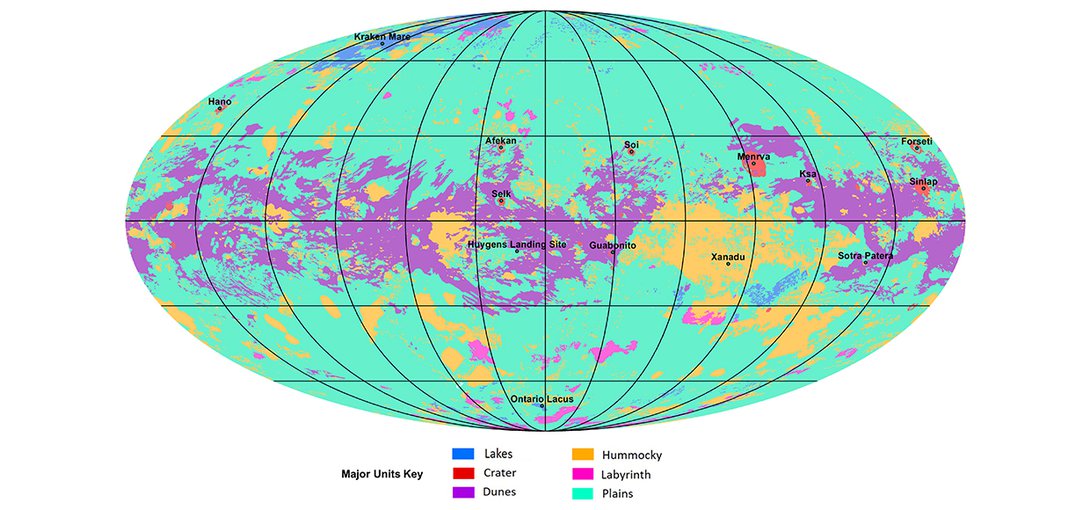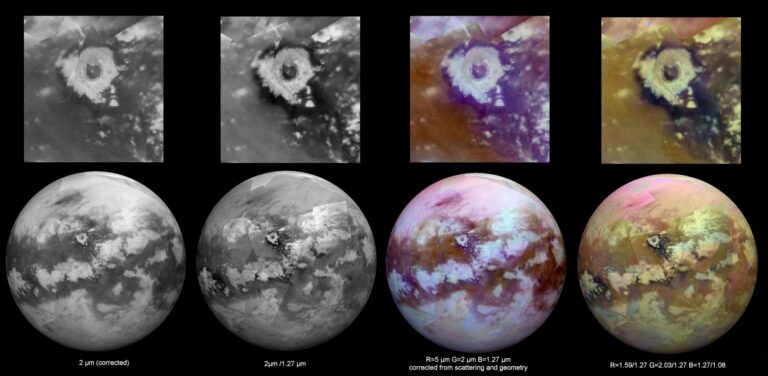Astronomers Have Successfully Mapped Titan’s Entire Surface for the First Time
Stunning Map of Titan’s Surface Uncovers Key Geological Features, Revealing Earth-Like Processes
A global map of Saturn’s moon Titan has been created using data from NASA’s Cassini mission, highlighting six key geological features: Lakes, the hummocky terrain, craters, the labyrinth terrain, plains and the dunes. Looking at this map, you realize how the active hydrocycle in Titan, based on methane, formed its surface like a terrestrial process. Plains take up 65% of the Titan’s surface and the dunes are common around the equatorial regions whereas the lakes are found in the polar regions. It is possible to state that studying these peculiarities is crucial for future missions, including the NASA’s Dragonfly mission to Titan in 2034.
A new study, supported in part by NASA Astrobiology Institute, has created the global geomorphological map of Titan using data obtained from Cassini. The map, scaled at 1:20,000,000, identifies six primary geological units: lakes, hummocky terrains, craters, complex terrains, level terrains and sand dunes.
Titan is now the focus of astrobiology within our solar system. It has its methane-based, hydrological cycle which created the surface features like the ones on earth. Although it is colder than Earth, darker, and has a different gravity, and made of different material, the moon is a great case of comparative planetology that allows scientists to learn more about our planet’s geological processes.

They commented it was only when Cassini was close to Titan it was possible to see the features hidden by the moon’s thick and hazy atmosphere. However, a team of researchers has developed a global map utilizing data received by the Cassini that will help to determine these characteristics. They identified the six geological units, and described their distribution on Cassini’s SAR image, which they augmented by using data provided by ISS and VIMS in areas not covered by SAR data.
According to the data obtained by Cassini, Titan is geologically saturated with organic substance, main of which are the hydrocarbons spread all over the surface of Titan. These hydrocarbons move and are deposited via such as erosion and cover nearly all or most of Titan’s surface, including the flat terrains and sand dunes depicted in the new map. Nevertheless, Titan’s plain areas are estimated cover approximately 65% of the entire moon’s surface.
With the help of the new Titan map, researchers can define sort of the geological divisions of Titan and their connections to unveil more about the processes that have molded Titan’s surface and its characteristics after the terrain formation. The above map clearly depicts that Titan is mostly comprising a sedimentary or depositional process and this cause large, flat regions on Titan that are actually sand dunes. There are also patterns based on latitude; there are sandy areas in equator, plains in middle latitudes, and lakes and Labyrinth terrains in poles.
This geomorphological map is much helpful in improving the knowledge of Titan’s surface which is very important for the further astrobiology-related missions to the Saturn system. NASA’s Dragonfly mission to Titan will be set for launch in 2026 and it is expected to land on Titan in 2034 and the probe will rove and collect samples from different regions on Titan.
The research was conducted by the international team of scientists and published in the Nature Astronomy under the title “A global geomorphologic map of Saturn’s moon Titan”. The research was partially supported by the NASA Astrobiology Institute (NAI), as part of the programs of NASA, whose goal is to understand the Universe and explore space, sustain human life for future exploration, and foster the next generation of explorers, statesmen, and innovators. It may be over fifty years after the first successful landing of a man on the moon; however, with NASA carrying on with the Artemis program of human exploration of the moon, the search for life on other planets is still the focus on any space exploration.
Do not forget to share your opinion with us to provide you with the best posts !




0 Comments